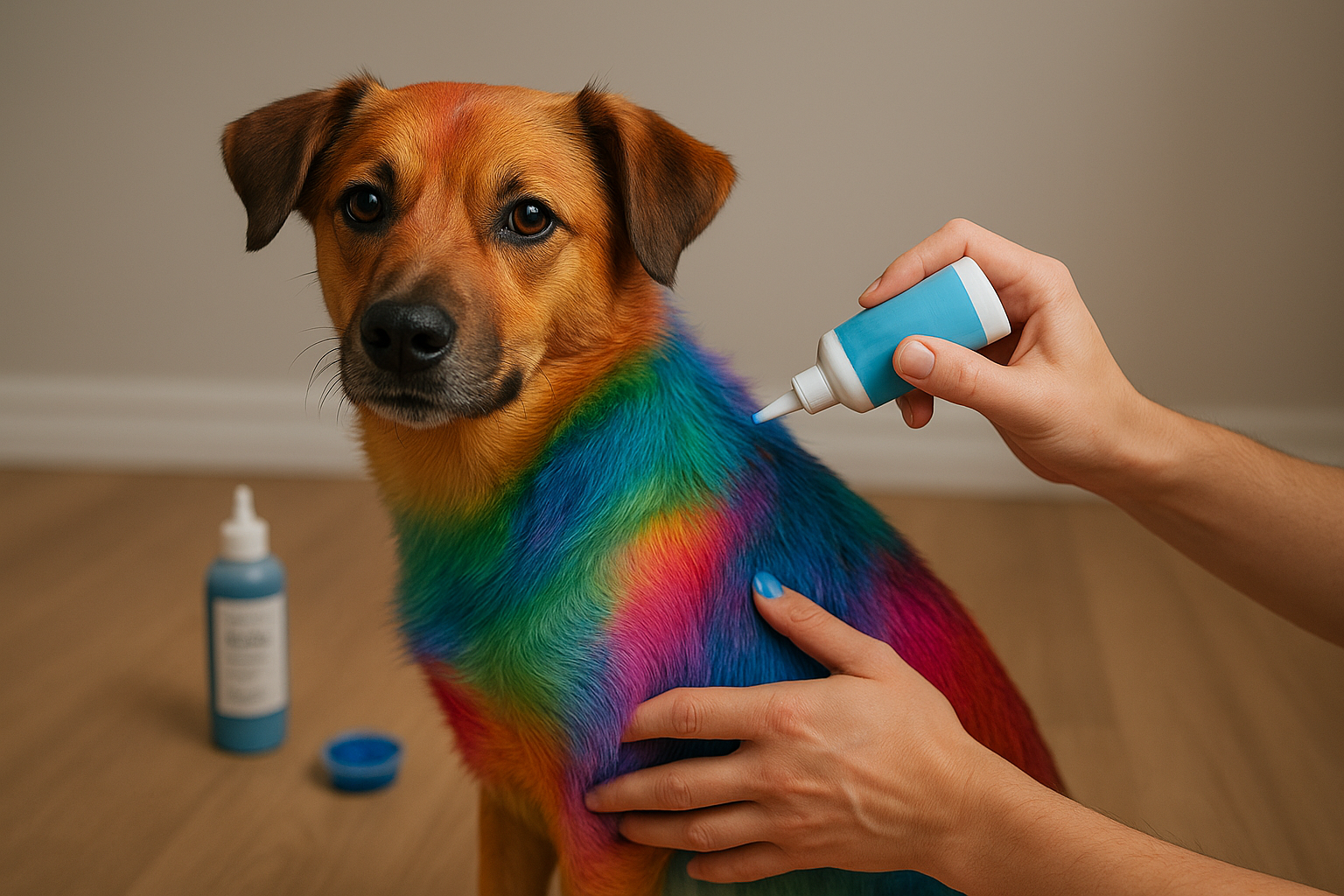I still remember the first time I thought, “Why not try colouring my dog’s hair?” My dog, Luna, has a beautiful white coat, and I was always curious how a little splash of colour could add fun to her look. I had seen creative grooming on social media and also met some groomers who were doing pet-safe dye work. That inspired me to learn more, experiment, and develop safe, compassionate techniques for using dog hair colour dye.
Dog hair colouring means using specially made dyes to change or enhance the colour of a dog’s fur. People are doing it to express personality, to make pets look cute for events, or just for creative grooming. It’s becoming more popular because pet-owners want to treat their dogs in more fun and personalized ways, plus there are more pet-safe options now.
Through all of this, I always keep safety first. Creativity is wonderful, but if it hurts or stresses the dog, it’s not worth it. My approach blends what I’ve learned from my own experiments, from groomers, and from veterinarians. In this article I share what dog hair colour dye is, how to choose it, how to apply it safely, what mistakes to avoid, creative ideas, and also why this work matters beyond just looks.
How My Passion for Dog Hair Colour Dyeing Began?
My first attempt at dyeing dog hair was clumsy. I bought a human hair dye set because it was cheap and colourful. I picked a light pastel blue, applied it timidly to Luna’s ears, thinking harmless. But within minutes, I saw her skin redden slightly, and she licked the dyeed fur. It wasn’t a disaster, but it was enough to teach me a lesson: not all dyes are safe; dogs are different.
I made several early mistakes. I used products with harsh chemicals, left the dye on too long, didn’t patch test, and sometimes applied too close to sensitive areas like ears. From these mistakes I learned better technique, better choice of products, and better procedures. Over time I discovered brands that explicitly say “pet-safe”, learned about temporary vs semi-permanent options, and adjusted timing and skin preparation.
What motivated me most was seeing dogs looking happy and owners being proud — but also seeing dogs uncomfortable when things go wrong. I wanted to develop a method where beauty doesn’t come at a cost to the dog’s wellbeing. That pushed me to learn about ingredient safety, to talk to vets, and to practice carefully, one small patch at a time.
Understanding Dog Hair Colour Dye — What It Really Is
When I first looked into dog hair colour dye, I saw a lot of confusion. So I want to explain clearly what makes a dye safe or unsafe for a dog.
First, safety depends on the ingredients. Dyes that are safe for dogs avoid things like ammonia, strong peroxide concentrations, and other harsh chemicals that are common in human hair dyes. Human dyes often contain substances that can burn skin, irritate sensitive areas, or cause allergic responses.
Second, pet-safe dye formulas are designed with dogs’ skin pH, fur type, and behaviour in mind. Dogs lick themselves. Their skin can be thinner in places. So any dye must be non-toxic, wash-out if needed, with mild preservatives, no strong scent, etc. Temporary, semi-permanent, or natural-based dyes are generally better.
Ingredient awareness matters because the wrong formula can cause skin irritation, burns, allergic reactions, or damage the coat (making it dry, brittle, or discoloured). Good dyes protect coat quality (shine, softness) as well as being safe for skin and general health. It’s not only what the dye does to the colour, but what it does to the dog’s health long term.
Choosing the Right Dog Hair Colour Dye for Your Pet
From my experience, I always consider a few key factors when selecting a dog hair colour dye.
First, evaluate the coat type. Is your dog’s fur long or short? Curly or straight? Thick or sparse? Light or dark base colour? Lighter fur shows colour more visibly; darker fur may need stronger or more pigmented dye. Also, dogs with dense under-coats might hold dye differently than single coats.
Second, skin sensitivity. Does the dog have history of skin allergies? Has she had hot spots, rashes, or sensitive ears? If yes, choose very mild, natural products, do patch tests, and avoid areas where skin is thin or delicate. Also, avoid dyes near eyes, mouth, nose, genitals. Vets often warn about irritation in mucous membranes.
Third, dye base. I trust dyes that are labelled “pet-safe”, “non-toxic”, “plant-based”, or “natural”. Some temporary dyes (sprays, washes, chalks) are safer because they wash out quickly. Semi-permanent ones last a few washes. Permanent ones are rare and higher risk. Also check for fragrance, preservatives, how easy it is to wash off.
Before using any product fully, I always do a patch test: small area of fur + skin, wait 24 hours, watch for redness, itching, licking. If everything is fine, I proceed. This simple test has saved me from many potential problems.
The Step-by-Step Process I Use to Dye Dog Hair Safely
Over the years, I have refined a process. This is what I do when I apply dog hair colour dye to ensure safety, good results, and comfort.
First, preparation. I bathe the dog if needed, making sure coat is clean, free of mats, dry or slightly damp depending on product instructions. I brush through to remove tangles. I protect ears, eyes, paws by keeping dye away. I set up in a well-ventilated area, with everything ready (towels, brush, gloves).
Then the application method. I follow the instructions from the product. With temporary dye, perhaps spray or brush. With semi-permanent, apply evenly, leave on for recommended time—not more. I monitor the dog’s behaviour: if she seems uncomfortable, I stop. I avoid mucous membranes and sensitive skin.
During the dye application, I try to make the dog relaxed: soft voice, breaks if needed, a treat or toy handy. Comfort matters. If dog is stressed, results may be worse, and safety risk increases.
After dyeing, rinse thoroughly until water runs clear (if the product is rinse-off type). Dry gently. Use gentle, dye-safe shampoo only when needed. Avoid over-washing. To maintain the colour, I avoid hot water, I avoid putting dog in sun constantly without protection (sun fades colours), and I brush coat gently to distribute natural oils.
Common Mistakes to Avoid When Using Dog Hair Colour Dye
Even with care, mistakes happen. I’ve made many; here are what I learned, and what I recommend avoiding.
One mistake: using human hair dye. It seemed easier, cheaper, more colourful, but human dye often has chemicals like ammonia, strong peroxide, or ingredients not tested on dogs. These are unsafe.
Another mistake: skipping the patch test. Early on, I dyed Luna’s tail before testing; she got irritation. If I had patch tested I would have seen sensitivity early.
Also, leaving dye on too long or applying too close to sensitive areas like ears, face, paws. These areas have thinner skin and more risk.
Failure to rinse well: leftover dye or residue can irritate the skin over time.
Ignoring aftercare: not using mild shampoo, washing too often, exposing to sun or swimming without care. These reduce the colour lifespan, damage coat, make dye fade badly.
If allergic reaction or colour mishap happens (e.g. colour uneven, stains where you don’t want), I recommend stopping use, rinsing thoroughly, consulting a vet if skin is irritated, and selecting gentler products in future.
Creative Colour Ideas and Styles I’ve Tried on Dogs
With proper safety, colouring dog fur can be fun and creative. I’ve explored several styles with Luna and other dogs.
I’ve tried pastel tones on light fur—pale pink ears, lavender tail tips—these show well and fade gently. On darker fur, metallic or bright tones show less, but still have a fun glow. Sometimes I used semi-permanent blues or greens for accents (feet, tail, ear tips) rather than full coat.
I also like matching dye style to breed or personality. For small toy breeds, delicate pastel “highlights” look cute. For larger or more rugged dogs, bolder accents (e.g. collar area, tail tip) look good without overwhelming. Personality matters: a hyperactive dog may shake a lot or lick, so simpler, smaller dye areas are safer.
Seasonal or event ideas: holidays (Halloween orange, Christmas red/green), birthdays (rainbow ears), themed photoshoots (stars, stripes). I always make sure temporary dyes are used so if the event’s over, the colour fades without harm.
The Joy and Responsibility Behind Dog Hair Colour Dyeing
There is a special joy when a dog wags her tail, looking at her reflection or enjoying the attention after a safe, fun dye job. It brings smiles, novelty, and a sense of bonding: you spent time caring creatively for your pet. That joy is real and meaningful.
At the same time, there is responsibility. Dog hair colour dye should never compromise the dog’s health. It is about considering what the dog tolerates, how they react, respecting their comfort. You may get beautiful looks, but if your dog is stressed, it’s not worth it. Always choosing safe products, monitoring reactions, consulting vets, and being willing to stop or change if something seems wrong.
If you are new, my advice is: start small. Try dyeing a small patch first. Use temporary or semi-permanent dye. Observe your dog’s behaviour. Be patient. Don’t aim for perfection—aim for safety and gentleness, combined with creativity. Over time you may develop more skill and confidence, and maybe try more bold designs, but always with the dog’s wellbeing in front.
Conclusion
My journey with dog hair colour dye has taught me many things: that passion for making pets look beautiful is rewarding when done safely; that mistakes are inevitable but can be powerful teachers; that the bond between pet and owner deepens when beauty is balanced with care.
If you try coloring your dog’s fur, remember: safety over speed, gentleness over flashy change. It’s better to go slow, use pet-safe products, test first, and always keep your dog’s comfort in mind.
Thank you for reading, and for loving your pets enough to treat them with creativity and kindness. If you approach dog hair colour dyeing with respect, it can be a joyful way to express personality—for you and your dog alike.
My name is Mustafa, and I have been blogging for over 5 years. I am passionate about sharing complete, accurate, and helpful information with my readers. Along with managing content on The Matcha Read, I also contribute blog posts to premium websites. My goal is to provide valuable insights in a clear and easy-to-understand way, so every reader walks away with useful knowledge.










